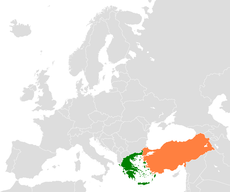Greece–Turkey border
This article needs additional citations for verification. (July 2019) |
| Greece–Turkey border Σύνορα Ελλάδας–Τουρκίας Türkiye–Yunanistan sınırı | |
|---|---|
 | |
| Characteristics | |
| Entities | |
| Length | 212 km (132 mi)[1] |

The Greece–Turkey border (Greek: Σύνορα Ελλάδας–Τουρκίας, romanized: Sýnora Elládas–Tourkías,Turkish: Türkiye–Yunanistan sınırı) is around 200 kilometres (120 mi) long, and separates Western Thrace in Greece from East Thrace in Turkey.
Course[]
It mostly follows the river Evros. At some places the border does not follow the main course of the river, mainly because the river has been straightened.
Barrier[]
It is the external border of the European Union. In 2012, a high border fence was erected along the land border where it is not separated by the river, because of the European migrant crisis.[2] In addition there is a sea border which sometimes goes through straits of a few kilometres width.
History[]

After the Greek War of Independence ended in 1829, the Greek state covered a fraction of its present territory. The first Greco-Ottoman border was the Aspropotamos–Spercheios line, followed in 1832 by the Arta–Volos line, which remained in effect until the annexation of Thessaly in 1881. The Balkan Wars of 1912–13 led to an extension of Greece northward, but at the same time, due to the advances of Serbia and Bulgaria, Greece ceased sharing a land border with the Ottoman Empire. This changed again in 1919–20, when Greece gained Western Thrace, Eastern Thrace, and the Smyrna Zone.
Following the Greco-Turkish War of 1919–1922, the present course of the border was established in 1923 by the Treaty of Lausanne, which also left the so-called "Karaağaç Triangle" (Greek: Τρίγωνο του Καραγάτς), a suburb of the city of Edirne, Turkey, as a Turkish exclave on the western side of the river. This territory was ceded during the Lausanne negotiations in exchange for Turkey abandoning its claim for war reparations on Greece.
The Greek-Turkish border, as defined by Lausanne, is effectively a reaffirmation of the Bulgarian-Turkish border set out by the Treaty of Constantinople (1913) ten years earlier, but this time with Greece as party, as Bulgaria had ceded Western Thrace to Greece in the Treaty of Neuilly after World War I.
2020[]
The neutrality of this section is disputed. (March 2020) |
In late February 2020, migrants started to gather at the Greek Turkish border after Turkish president Recep Tayyip Erdoğan announced that he would no longer "block" refugees and migrants' "access to the border", and opened the border with Greece.[3][4] Turkey's government was also accused of pushing refugees into Europe for political and monetary gain.[5]
During March 2020, the migrants repeatedly tried to cross the border fence but they were blocked by Greek army, police and small detachments of policemen from Austria, Cyprus, Czech Republic, and Poland, who defended the fence and resisted the migrants using tear gas. Among those who illegally attempted to cross were individuals from Africa, Iran, Afghanistan, and Syria. Greece responded by refusing to accept asylum applications for a month.[6][7] As migrants tried to breach the border fence using tools, they also set fires, threw stones, and Molotov cocktail firebombs over to the Greek side and there are videos of Turkish security forces in uniform and plain-clothes, firing tear gas at Greek forces and a Turkish armored vehicle attempting to pull down the border fence by tugging on an attached cable.[better source needed][3] Sources also verified that there is an undisclosed detention center that founded by Greek forces for expelling the migrants without any legal process.[8]
By 11 March 2020, 348 people who illegally crossed the borders had been arrested and 44,353 cases of unlawful entry had been prevented.[citation needed]
Crossings[]
There are three crossings along the entire border, two for vehicular traffic and one for vehicular and rail traffic. The busiest of three, İpsala, is among the busiest border checkpoints in the world.
| Province | Province | Opened | Route in Turkey | Route in Greece | Status | ||
|---|---|---|---|---|---|---|---|
| Pazarkule | Edirne | Kastanies | Kastanies | 20 April 1952 | Open | ||
| İpsala | Edirne | Kipoi | Kipoi | 10 July 1961 | Open | ||
| Uzunköprü | Edirne | Pythio | Pythio | 4 September 1953 | Open |
See also[]
References[]
- ^ "Türkiyenin Komşuları ve Coğrafi Sınırları". 14 February 2016. Archived from the original on 14 February 2016.
- ^ Why Greece Shut The Shortest, Safest Route For Migrants And Refugees. The Huffington Post. Published on 09/24/2015.
- ^ Jump up to: a b Aris Roussinos (3 April 2020). "What the Hell Is Happening With Migrants in Greece?".
- ^ Anthee Carassava (March 26, 2020). "Migration to Greece Drops Dramatically, but EU Seeks Greater Refugee Coronavirus Protection". Voice of America.
- ^ Seth J. Frantzman (15 March 2020). "Turkey cynically pushes migrants toward coronavirus-hit Europe". Jerusalem Post.
- ^ "'Are we in Greece?': Migrants seize their chance in Europe quest". news.yahoo.com. Retrieved 2020-03-03.
- ^ "Greece blocks thousands of migrants trying to enter from Turkey". France 24. 2020-03-01. Retrieved 2020-03-03.
- ^ Clapp, Alex (16 September 2020). "Europe Turns Its Back on Refugees—and Its Own Values". Foreign Affairs. ISSN 0015-7120. Retrieved 24 December 2020.
- Greece–Turkey border
- Borders of Greece
- Borders of Turkey
- Thrace
- International borders
- Foreign relations stubs
